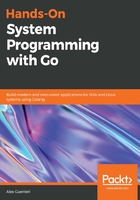
上QQ阅读APP看书,第一时间看更新
Mounting and unmounting
The operating system splits the hard drive into logical units called partitions, and each one can be a different file system. When the operating system starts, it makes some partitions available using the mount command for each line of the /etc/fstab file, which looks more or less like this:
# device # mount-point # fstype # options # dumpfreq # passno
/dev/sda1 / ext4 defaults 0 1
This configuration mounts /dev/sda1 to /disk using an ext4 filesystem and default options, no backing up (0), and root integrity check (1). The mount command can be used at any time to expose partitions in the filesystem. Its counterpart, umount, is needed to remove these partitions from the main filesystem. The empty directory used for the operation is called mount point, and it represents the root under which the filesystem is connected.